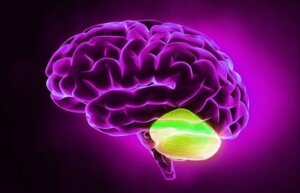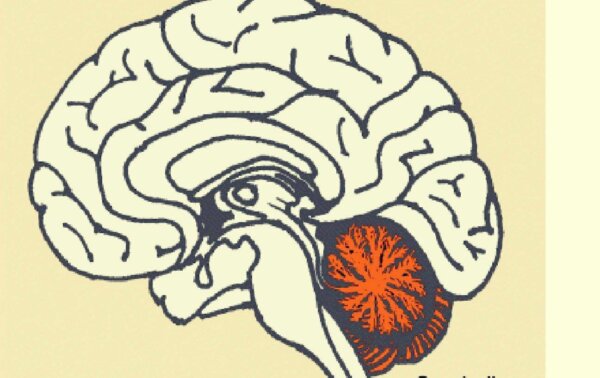The Cerebellum and Divergent Thinking


Written and verified by the psychologist Valeria Sabater
The relationship between the cerebellum and divergent thinking is amazing, disturbing, and decisive. This is interesting because, until recently, people took for granted the fact that the only functions performed by this organ were related to motor memory or coordination. Today, it’s clear this is decisive in a significant part of the higher cognitive processes.
You might find it interesting to know that Leonardo da Vinci was one of the first persons to be fascinated by the cerebellum. He found that area located in the posterior cranial fossa. He referred to it as “little brain” (cerebellum) in one of his furtive nights of research with corpses to understand human physiology around the year 1504.
Later, between the 17th and 19th centuries, someone discovered the role of the cerebellum in dimensions such as balance, posture, motor learning, and fine motor skills (such as being able to write). The small brain has been as underestimated as misunderstood, even though many neurologists already sensed its relevance.
It’s time to give it the relevance it deserves and understand its function in your daily lives.
“Om meditation makes the mind spacious. It gives the freedom for focus and divergent thinking. Divergent thinking is the center of human creativity.”
-Amit Ray-

The relationship between the cerebellum and divergent thinking
The cerebellum accounts for a little more than 10% of the total brain volume. However, it houses almost 80% of the total number of brain neurons. Something like this already presents an unavoidable clue that its transcendence may be much greater than researchers initially thought. Therefore, it’s logical to deduce that it can take care of something more than the motor tasks.
For example, thanks to this organ you can drive a car or ride a bicycle without having to think about how to do it. In other words, the cerebellum facilitates and integrates the motor memory and automates a large part of your daily movements. However, it wasn’t until the last decade when scientists began to pay more attention to this area in order to discover its multiple sides.
The cerebellum and divergent thinking
The relevance of the cerebellum in functions such as working memory and creativity was already advanced in 2007. You can find evidence of it in this study by Dr. Jalil Pasl, published in the Creativity Research Journal. However, Christopher J. Steele of the Max Planck Institute for Human Cognitive and Brain Sciences in Leipzig revealed something even more decisive recently.
- The cerebellum is densely connected with multiple areas of the brain. In fact, this region is so compact and highly interconnected that it’s present in a large number of higher cognitive processes.
- Also, the cerebellum is related to competencies such as communication, creativity, and the ability to think in original and innovative ways (divergent thinking).
- Autism spectrum disorders (ASD) are closely related to the Purkinje cells and the cerebellum. Actually, children with higher connectivity between the brain and the cerebellum have more effective motor skills and can develop better communication and socialization skills.
Allan Reiss, professor of radiology, psychiatry, and behavioral science at Stanford University, once said that: “Our findings represent a breakthrough in our understanding of the physiology of creativity based on the cerebellum. We found that the activation of executive control centers in this region allows us to plan, organize, and manage tasks in a creative way. Divergent thinking is also linked to this area and sparks art, science, and business”.
The cerebellum and fluid intelligence
This refers to the ability to perform mental calculations and solve problems originally and without previous knowledge. In other words, it defines the ability to solve problems without having a career or reading an instruction manual.
The cerebellum and divergent thinking are related to this type of intelligence. Mihály Csíkszentmihályi points out that this type of competition is what achieves the greatest synchronization and connectivity of the brain’s hemispheres. It’s clear that the cerebellum is also a part of this process.

There’s a serious problem with the cerebellum
Now you know the relevance of this organ. It’s clear that the relationship between the cerebellum and divergent thinking is significant. However, there’s one problem. Well, several, actually.
- The cerebellum atrophies due to lack of physical activity and a passive lifestyle.
- Also, excessive exposure to computer screens and cell phones reduces its size and connectivity.
These two dimensions should be serious enough to make you think. People rely on technology too much these days, nearly to the point it does all of the “thinking”. When was the last time you did a mental calculation? Can you find your way around a city without a GPS?
Moreover, handwriting is also bound for extinction because, why write anything down when you have a word processor? You may not be aware of it but this has a serious impact on the plasticity of your brain.
Furthermore, letting your devices replace many of the tasks you used to do mentally or manually atrophies your brain. It leads to slow and premature aging of an essential region for all humans beings. Just think about it.
The relationship between the cerebellum and divergent thinking is amazing, disturbing, and decisive. This is interesting because, until recently, people took for granted the fact that the only functions performed by this organ were related to motor memory or coordination. Today, it’s clear this is decisive in a significant part of the higher cognitive processes.
You might find it interesting to know that Leonardo da Vinci was one of the first persons to be fascinated by the cerebellum. He found that area located in the posterior cranial fossa. He referred to it as “little brain” (cerebellum) in one of his furtive nights of research with corpses to understand human physiology around the year 1504.
Later, between the 17th and 19th centuries, someone discovered the role of the cerebellum in dimensions such as balance, posture, motor learning, and fine motor skills (such as being able to write). The small brain has been as underestimated as misunderstood, even though many neurologists already sensed its relevance.
It’s time to give it the relevance it deserves and understand its function in your daily lives.
“Om meditation makes the mind spacious. It gives the freedom for focus and divergent thinking. Divergent thinking is the center of human creativity.”
-Amit Ray-

The relationship between the cerebellum and divergent thinking
The cerebellum accounts for a little more than 10% of the total brain volume. However, it houses almost 80% of the total number of brain neurons. Something like this already presents an unavoidable clue that its transcendence may be much greater than researchers initially thought. Therefore, it’s logical to deduce that it can take care of something more than the motor tasks.
For example, thanks to this organ you can drive a car or ride a bicycle without having to think about how to do it. In other words, the cerebellum facilitates and integrates the motor memory and automates a large part of your daily movements. However, it wasn’t until the last decade when scientists began to pay more attention to this area in order to discover its multiple sides.
The cerebellum and divergent thinking
The relevance of the cerebellum in functions such as working memory and creativity was already advanced in 2007. You can find evidence of it in this study by Dr. Jalil Pasl, published in the Creativity Research Journal. However, Christopher J. Steele of the Max Planck Institute for Human Cognitive and Brain Sciences in Leipzig revealed something even more decisive recently.
- The cerebellum is densely connected with multiple areas of the brain. In fact, this region is so compact and highly interconnected that it’s present in a large number of higher cognitive processes.
- Also, the cerebellum is related to competencies such as communication, creativity, and the ability to think in original and innovative ways (divergent thinking).
- Autism spectrum disorders (ASD) are closely related to the Purkinje cells and the cerebellum. Actually, children with higher connectivity between the brain and the cerebellum have more effective motor skills and can develop better communication and socialization skills.
Allan Reiss, professor of radiology, psychiatry, and behavioral science at Stanford University, once said that: “Our findings represent a breakthrough in our understanding of the physiology of creativity based on the cerebellum. We found that the activation of executive control centers in this region allows us to plan, organize, and manage tasks in a creative way. Divergent thinking is also linked to this area and sparks art, science, and business”.
The cerebellum and fluid intelligence
This refers to the ability to perform mental calculations and solve problems originally and without previous knowledge. In other words, it defines the ability to solve problems without having a career or reading an instruction manual.
The cerebellum and divergent thinking are related to this type of intelligence. Mihály Csíkszentmihályi points out that this type of competition is what achieves the greatest synchronization and connectivity of the brain’s hemispheres. It’s clear that the cerebellum is also a part of this process.

There’s a serious problem with the cerebellum
Now you know the relevance of this organ. It’s clear that the relationship between the cerebellum and divergent thinking is significant. However, there’s one problem. Well, several, actually.
- The cerebellum atrophies due to lack of physical activity and a passive lifestyle.
- Also, excessive exposure to computer screens and cell phones reduces its size and connectivity.
These two dimensions should be serious enough to make you think. People rely on technology too much these days, nearly to the point it does all of the “thinking”. When was the last time you did a mental calculation? Can you find your way around a city without a GPS?
Moreover, handwriting is also bound for extinction because, why write anything down when you have a word processor? You may not be aware of it but this has a serious impact on the plasticity of your brain.
Furthermore, letting your devices replace many of the tasks you used to do mentally or manually atrophies your brain. It leads to slow and premature aging of an essential region for all humans beings. Just think about it.
All cited sources were thoroughly reviewed by our team to ensure their quality, reliability, currency, and validity. The bibliography of this article was considered reliable and of academic or scientific accuracy.
- Pasl A. Jalil (2007) Working Memory, Cerebellum, and Creativity, Creativity Research Journal, 19:1, 39-45, DOI: 10.1080/10400410709336878
- Wagner, M. J., & Luo, L. (2020, January 1). Neocortex–Cerebellum Circuits for Cognitive Processing. Trends in Neurosciences. Elsevier Ltd. https://doi.org/10.1016/j.tins.2019.11.002
This text is provided for informational purposes only and does not replace consultation with a professional. If in doubt, consult your specialist.







